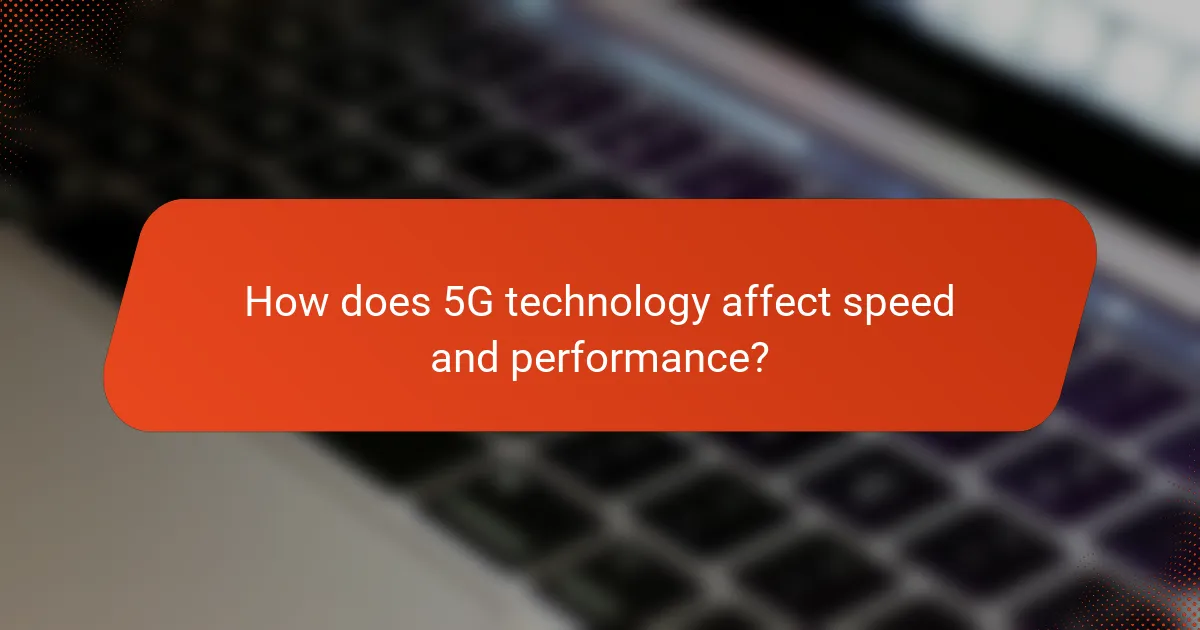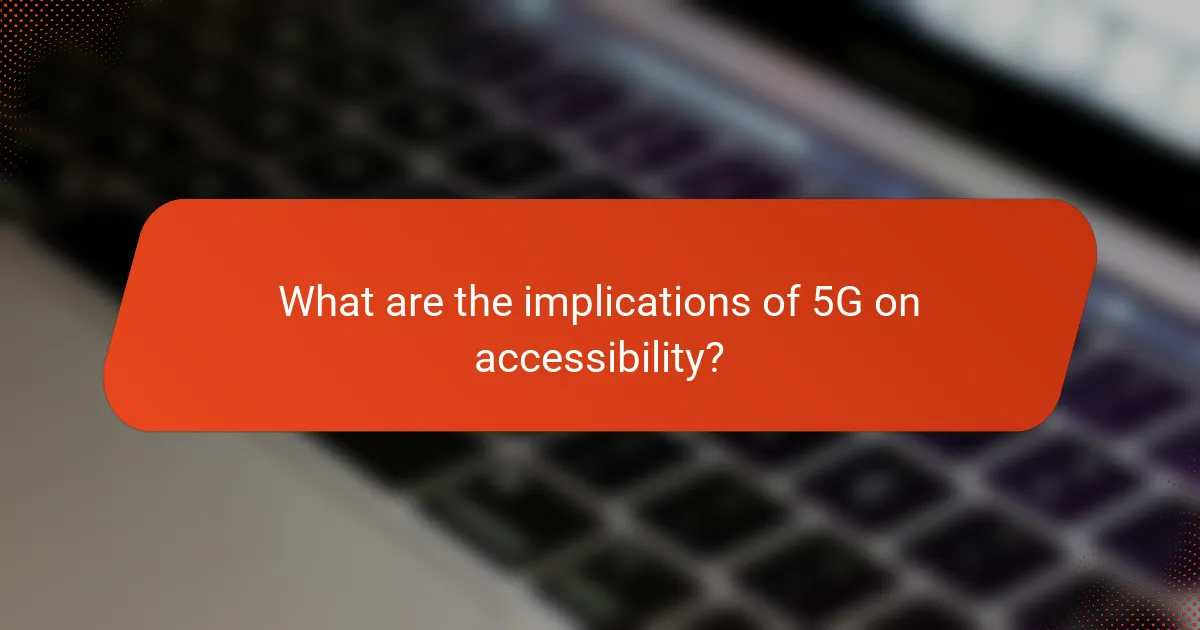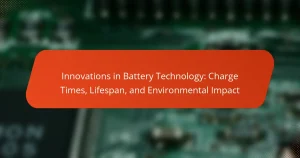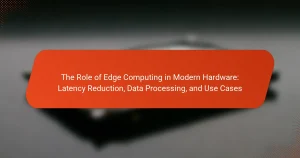5G technology represents a significant advancement in communication, characterized by key breakthroughs such as enhanced mobile broadband, ultra-reliable low-latency communication, and massive machine-type communications. Enhanced mobile broadband offers data rates up to 10 Gbps, while ultra-reliable low-latency communication reduces latency to as low as 1 millisecond, facilitating real-time applications. Additionally, massive machine-type communications enable connectivity for a vast number of devices, supporting the Internet of Things (IoT) and contributing to the development of smarter cities. These improvements not only enhance user experiences in areas like streaming and gaming but also increase accessibility for individuals with disabilities, allowing for better utilization of assistive technologies.

What are the key breakthroughs in 5G technology?
Key breakthroughs in 5G technology include enhanced mobile broadband, ultra-reliable low-latency communication, and massive machine-type communications. Enhanced mobile broadband significantly increases data rates, achieving speeds up to 10 Gbps. Ultra-reliable low-latency communication reduces latency to as low as 1 millisecond, enabling real-time applications. Massive machine-type communications support a vast number of devices simultaneously, facilitating the Internet of Things (IoT). These advancements enable smarter cities and improved connectivity. According to the International Telecommunication Union, 5G can support up to 1 million devices per square kilometer.
How does 5G technology differ from previous generations?
5G technology differs from previous generations primarily in speed, capacity, and latency. It offers download speeds up to 10 Gbps, significantly faster than the 1 Gbps maximum of 4G. The capacity of 5G networks allows for up to 1 million devices per square kilometer, compared to 4G’s 100,000 devices. Latency in 5G can be as low as 1 millisecond, while 4G typically has latencies around 30-50 milliseconds. These improvements enable more reliable connections for applications like autonomous vehicles and smart cities. 5G also utilizes new spectrum bands, including millimeter waves, which enhance performance in densely populated areas. These advancements represent a substantial leap in mobile communication technology.
What technological advancements contribute to 5G’s capabilities?
Technological advancements that contribute to 5G’s capabilities include millimeter wave technology, massive MIMO, and beamforming. Millimeter wave technology enables higher frequency bands, allowing for increased data rates. Massive MIMO utilizes multiple antennas to improve capacity and efficiency. Beamforming directs signals to specific devices, enhancing signal quality and range. Additionally, network slicing allows for customized virtual networks tailored to specific needs. These advancements collectively enhance overall communication speed and accessibility in 5G networks.
How does 5G enhance data transmission rates?
5G enhances data transmission rates by utilizing higher frequency bands. These frequency bands allow for greater bandwidth, which increases data capacity. Additionally, 5G employs advanced technologies like Massive MIMO and beamforming. Massive MIMO uses multiple antennas to improve signal quality and capacity. Beamforming directs signals toward specific users, reducing interference. As a result, 5G can achieve speeds up to 10 Gbps. This is significantly faster than 4G, which typically offers speeds around 1 Gbps. The increased capacity and efficiency of 5G networks enable more devices to connect simultaneously without degrading performance.
What impact do these breakthroughs have on communication?
Breakthroughs in 5G technology significantly enhance communication. They enable faster data transmission, reducing latency to as low as 1 millisecond. This speed allows for real-time communication, improving video calls and online gaming experiences. Enhanced bandwidth supports more devices simultaneously without degradation in performance. 5G also facilitates advanced applications like augmented reality and IoT, transforming how people interact. According to a study by Ericsson, 5G can increase mobile data traffic by up to 1000 times compared to 4G. These advancements lead to more efficient communication in personal and professional settings.
How does 5G improve mobile communication experiences?
5G improves mobile communication experiences by providing significantly higher data speeds. It can achieve speeds up to 10 Gbps, which is up to 100 times faster than 4G. This increased speed allows for quicker downloads and smoother streaming of high-definition content.
Additionally, 5G reduces latency to as low as 1 millisecond. This minimal delay enhances real-time applications, such as gaming and video conferencing. The technology also supports a higher density of connected devices. It can connect up to 1 million devices per square kilometer, facilitating the growth of the Internet of Things (IoT).
Moreover, 5G networks offer improved reliability and coverage. This ensures stable connections even in crowded areas. Enhanced capacity allows for better performance in urban environments. Overall, 5G transforms mobile communication by making it faster, more efficient, and more accessible.
What role does 5G play in enabling real-time communication?
5G plays a crucial role in enabling real-time communication by providing significantly higher data transfer speeds and lower latency. This technology allows for data transmission rates up to 10 Gbps, which is up to 100 times faster than 4G. The latency in 5G networks can be as low as 1 millisecond, facilitating instantaneous communication.
This speed and responsiveness are essential for applications like video conferencing, online gaming, and remote surgeries. The increased bandwidth supports multiple devices simultaneously without degradation of service.
Moreover, 5G’s ability to connect a vast number of devices enhances the Internet of Things (IoT), allowing for seamless communication between smart devices. This interconnectedness is vital for real-time data sharing and responses in various sectors, including healthcare, transportation, and emergency services.
Overall, 5G’s advancements create a robust framework for real-time communication, significantly impacting how individuals and organizations interact.

How does 5G technology affect speed and performance?
5G technology significantly enhances speed and performance. It offers download speeds up to 10 Gbps. This is approximately 100 times faster than 4G networks. Latency is also reduced to 1 millisecond or less. This improvement allows for real-time communication and faster response times in applications. The increased bandwidth supports more devices simultaneously. This is crucial for the growing Internet of Things (IoT). Enhanced speed and performance lead to better user experiences in streaming and gaming. These advancements make 5G a transformative technology in communication.
What are the expected speed improvements with 5G?
5G technology is expected to deliver speed improvements of up to 100 times faster than 4G. This translates to download speeds exceeding 10 Gbps in ideal conditions. The latency in 5G networks is also significantly reduced, potentially dropping to as low as 1 millisecond. These enhancements enable faster data transfer and improved user experiences. The increased capacity allows more devices to connect simultaneously without compromising speed. According to the International Telecommunication Union, 5G can support up to 1 million devices per square kilometer. This capability facilitates the growth of smart cities and IoT applications. Overall, 5G represents a substantial leap in mobile network performance.
How does latency in 5G compare to previous technologies?
Latency in 5G is significantly lower than in previous technologies. 5G latency can reach as low as 1 millisecond. In contrast, 4G networks typically have latency around 30 to 50 milliseconds. This reduction enables real-time communication and faster response times. Enhanced latency in 5G supports applications like autonomous vehicles and remote surgery. The improved performance is due to advanced technologies such as network slicing and edge computing. Studies show that lower latency enhances user experience and application efficiency.
What factors influence the speed of 5G networks?
The speed of 5G networks is influenced by several key factors. These factors include frequency bands, network density, and user equipment. Higher frequency bands, such as millimeter waves, provide faster data rates but have shorter range. Network density refers to the number of cell towers in a given area. More towers lead to improved coverage and speed. User equipment capabilities also play a crucial role. Devices must support 5G standards to achieve maximum speeds. Additionally, environmental factors like buildings and trees can obstruct signals, impacting overall speed. Finally, network congestion can slow down speeds when many users access the network simultaneously.
How does increased speed benefit various applications?
Increased speed benefits various applications by enhancing performance and efficiency. For example, in healthcare, faster data transfer allows for real-time patient monitoring. This can improve decision-making and patient outcomes. In autonomous vehicles, increased speed facilitates quicker data processing, which is crucial for safety. In entertainment, faster streaming reduces buffering and improves user experience. Furthermore, in industrial automation, speed boosts productivity by enabling quicker machine communication. According to a report by Ericsson, 5G networks can achieve speeds up to 10 Gbps, significantly outpacing previous technologies. This increased speed supports the development of innovative applications across multiple sectors.
What industries stand to gain the most from faster speeds?
Telecommunications, healthcare, and transportation industries stand to gain the most from faster speeds. Telecommunications will benefit from enhanced mobile broadband and reduced latency. This improvement enables seamless streaming and better connectivity. Healthcare can leverage faster speeds for telemedicine and real-time patient monitoring. This technology allows for quicker data transmission, improving patient outcomes. Transportation will see advancements in autonomous vehicles and smart traffic management. Faster speeds facilitate real-time data exchange, enhancing safety and efficiency. These industries are poised for significant transformation due to the capabilities of 5G technology.
How does speed enhancement change user experiences?
Speed enhancement significantly improves user experiences by reducing latency and increasing data transfer rates. Users benefit from faster downloads and uploads, enhancing their ability to stream content seamlessly. Real-time applications, such as video conferencing and online gaming, perform better with lower delays. Enhanced speed allows for more devices to connect simultaneously without performance degradation. According to a study by Ericsson, 5G networks can achieve speeds up to 10 Gbps, which is substantially higher than previous generations. This increase in speed leads to more efficient workflows and greater user satisfaction. Overall, speed enhancement transforms how users interact with technology, making experiences more fluid and responsive.

What are the implications of 5G on accessibility?
5G technology significantly enhances accessibility for individuals with disabilities. It provides faster data transmission and lower latency, improving real-time communication tools. This enables better use of assistive technologies, such as speech recognition and video conferencing. Enhanced mobile broadband facilitates access to vital services and information. According to a report by the International Telecommunication Union, 5G can support a higher density of connected devices, benefiting smart cities and IoT applications. These advancements create more inclusive environments, allowing for greater participation in society.
How does 5G technology expand internet accessibility?
5G technology expands internet accessibility by providing faster data speeds and lower latency. It enables more devices to connect simultaneously without degradation in performance. This increased capacity supports rural and underserved areas, where traditional broadband may be lacking. According to a study by the GSMA, 5G can potentially reach up to 1.7 billion people in rural regions globally. Enhanced mobile broadband allows users to access high-quality video and online services without interruptions. Furthermore, 5G networks facilitate the deployment of Internet of Things (IoT) devices, increasing connectivity options. This technology also supports innovative solutions like remote healthcare and smart city applications, broadening access to essential services.
What are the potential barriers to 5G accessibility?
The potential barriers to 5G accessibility include infrastructure limitations, high deployment costs, and regulatory challenges. Infrastructure limitations arise from the need for extensive networks of small cell towers. These towers require significant investment and urban planning to install. High deployment costs can deter service providers from investing in 5G technology. This is particularly true in rural areas where the return on investment may be lower. Regulatory challenges can slow down the approval process for new installations. Local governments may impose strict zoning laws that complicate deployment efforts. Additionally, the lack of compatible devices can hinder user access to 5G networks. The transition from 4G to 5G requires new technology that not all consumers possess.
How can 5G improve connectivity in rural areas?
5G can significantly improve connectivity in rural areas by providing faster data speeds and lower latency. This technology enables high-capacity networks that can support more devices simultaneously. Rural regions often face challenges with limited internet access and slow speeds. 5G addresses these issues by utilizing advanced infrastructure, such as small cell technology and beamforming. For example, research from the Federal Communications Commission indicates that 5G can deliver speeds up to 10 Gbps. This increase in speed can enhance telehealth services, remote education, and agricultural technology in rural communities. Moreover, 5G’s ability to connect IoT devices can lead to smarter farming practices and improved resource management.
What strategies can enhance the benefits of 5G accessibility?
Implementing network slicing can enhance the benefits of 5G accessibility. Network slicing allows multiple virtual networks to operate on a single physical network. This enables tailored services for different user requirements, optimizing performance. Increasing infrastructure investment is another strategy to improve accessibility. Enhanced infrastructure leads to wider coverage and reduced dead zones. Collaborating with local governments can also facilitate faster deployment of 5G networks. This collaboration can streamline regulations and permit processes. Additionally, promoting public-private partnerships can drive innovation in 5G applications. These partnerships can leverage resources and expertise for better service delivery. Lastly, increasing public awareness about 5G benefits can drive user adoption. Educating users on 5G capabilities can help them utilize the technology effectively.
How can communities leverage 5G technology for growth?
Communities can leverage 5G technology for growth by enhancing connectivity and enabling smart infrastructure. 5G offers high-speed internet with low latency, which supports real-time data transfer. This technology can facilitate remote work and online education, increasing access to opportunities. Local businesses can utilize 5G for improved customer engagement through mobile applications. Enhanced connectivity can attract tech companies, fostering economic development. Additionally, 5G can support IoT devices for efficient city management, improving public services. According to a report by the GSMA, 5G could contribute $2.2 trillion to the global economy by 2030, demonstrating its potential for community growth.
What best practices should be followed for adopting 5G solutions?
Organizations should follow several best practices for adopting 5G solutions. First, they must assess their current infrastructure to ensure compatibility with 5G technology. This includes evaluating hardware, software, and network capabilities. Next, businesses should prioritize security measures to protect sensitive data during the transition. Implementing robust cybersecurity protocols is essential.
Additionally, organizations should engage in thorough training for employees to effectively utilize new 5G capabilities. This ensures that staff can leverage the enhanced speed and connectivity offered by 5G. Collaborating with experienced vendors can also facilitate a smoother integration process.
Moreover, businesses should conduct pilot programs to test 5G applications before full-scale deployment. This allows for the identification of potential issues and adjustments as needed. Finally, organizations should continuously monitor performance and gather feedback to optimize their 5G solutions. These practices help maximize the benefits of 5G technology while minimizing risks.
What are the common challenges faced in implementing 5G technology?
Common challenges in implementing 5G technology include infrastructure costs, regulatory hurdles, and spectrum allocation. Building the necessary infrastructure requires significant investment from telecom companies. This includes the installation of new base stations and fiber-optic cables. Regulatory hurdles arise as governments establish guidelines and policies for 5G deployment. These can delay the rollout process. Spectrum allocation is another challenge, as 5G requires access to specific frequency bands. Competing demands for spectrum can complicate this process. Additionally, there are concerns about security and privacy with increased connectivity. Finally, public acceptance and understanding of 5G technology can impact its adoption.
Breakthroughs in 5G technology represent significant advancements in communication, speed, and accessibility. Key developments include enhanced mobile broadband with speeds up to 10 Gbps, ultra-reliable low-latency communication reducing latency to 1 millisecond, and massive machine-type communications supporting up to 1 million devices per square kilometer. These improvements enable real-time applications and facilitate the growth of the Internet of Things (IoT), transforming user experiences across various industries. The article will explore how these breakthroughs enhance connectivity, impact data transmission rates, and address accessibility challenges, particularly in rural areas.




